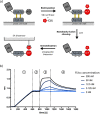An improved yeast surface display platform for the screening of nanobody immune libraries
- PMID: 30674983
- PMCID: PMC6344588
- DOI: 10.1038/s41598-018-37212-3
An improved yeast surface display platform for the screening of nanobody immune libraries
Abstract
Fusions to the C-terminal end of the Aga2p mating adhesion of Saccharomyces cerevisiae have been used in many studies for the selection of affinity reagents by yeast display followed by flow cytometric analysis. Here we present an improved yeast display system for the screening of Nanobody immune libraries where we fused the Nanobody to the N-terminal end of Aga2p to avoid steric hindrance between the fused Nanobody and the antigen. Moreover, the display level of a cloned Nanobody on the surface of an individual yeast cell can be monitored through a covalent fluorophore that is attached in a single enzymatic step to an orthogonal acyl carrier protein (ACP). Additionally, the displayed Nanobody can be easily released from the yeast surface and immobilised on solid surfaces for rapid analysis. To prove the generic nature of this novel Nanobody discovery platform, we conveniently selected Nanobodies against three different antigens, including two membrane proteins.
Conflict of interest statement
The authors declare no competing interests.
Figures






Similar articles
-
[Advances in nanobody screening technology].Sheng Wu Gong Cheng Xue Bao. 2024 Feb 25;40(2):350-366. doi: 10.13345/j.cjb.230472. Sheng Wu Gong Cheng Xue Bao. 2024. PMID: 38369826 Review. Chinese.
-
Isolation of Single-Domain Antibodies to Transmembrane Proteins Using Magnetized Yeast Cell Targets.Methods Mol Biol. 2022;2446:95-119. doi: 10.1007/978-1-0716-2075-5_5. Methods Mol Biol. 2022. PMID: 35157270
-
Screening Yeast Display Libraries against Magnetized Yeast Cell Targets Enables Efficient Isolation of Membrane Protein Binders.ACS Comb Sci. 2019 Dec 9;21(12):817-832. doi: 10.1021/acscombsci.9b00147. Epub 2019 Nov 20. ACS Comb Sci. 2019. PMID: 31693340
-
Selection of Functional Intracellular Nanobodies.SLAS Discov. 2019 Aug;24(7):703-713. doi: 10.1177/2472555219853235. Epub 2019 Jun 7. SLAS Discov. 2019. PMID: 31173539 Review.
-
Evaluation of the yeast surface display system for screening of functional nanobodies.AMB Express. 2020 Mar 16;10(1):51. doi: 10.1186/s13568-020-00983-y. AMB Express. 2020. PMID: 32180052 Free PMC article.
Cited by
-
Allosteric nanobodies to study the interactions between SOS1 and RAS.Nat Commun. 2024 Jul 23;15(1):6214. doi: 10.1038/s41467-024-50349-2. Nat Commun. 2024. PMID: 39043660 Free PMC article.
-
A Protein-Engineered, Enhanced Yeast Display Platform for Rapid Evolution of Challenging Targets.ACS Synth Biol. 2021 Dec 17;10(12):3445-3460. doi: 10.1021/acssynbio.1c00395. Epub 2021 Nov 22. ACS Synth Biol. 2021. PMID: 34809429 Free PMC article.
-
Bulk Reformatting of Antibody Fragments Displayed on the Surface of Yeast Cells to Final IgG Format for Mammalian Production.Methods Mol Biol. 2023;2681:291-311. doi: 10.1007/978-1-0716-3279-6_16. Methods Mol Biol. 2023. PMID: 37405654
-
Surface Engineering of Escherichia coli to Display Its Phytase (AppA) and Functional Analysis of Enzyme Activities.Curr Issues Mol Biol. 2024 Apr 17;46(4):3424-3437. doi: 10.3390/cimb46040215. Curr Issues Mol Biol. 2024. PMID: 38666945 Free PMC article.
-
ssDNA recombineering boosts in vivo evolution of nanobodies displayed on bacterial surfaces.Commun Biol. 2021 Oct 7;4(1):1169. doi: 10.1038/s42003-021-02702-0. Commun Biol. 2021. PMID: 34621006 Free PMC article.
References
Publication types
MeSH terms
Substances
LinkOut - more resources
Full Text Sources
Other Literature Sources
Research Materials

